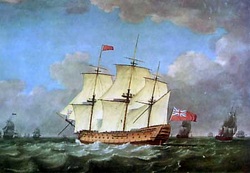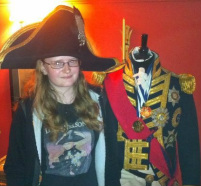
Anybody who knows anything about Nelson would have heard her name. They most likely would have seen photos or paintings of her. Some may have been fortunate enough to stroll along her deck. After his death on her orlop deck during the Battle of Trafalgar, HMS Victory very quickly became part of the Nelson legend. Ever since their names have been bound together and the name HMS Victory is as immortalised as Nelson's.
But at Trafalgar the Victory was very much an elderly ship- not far from the age of Nelson himself- and had already seen much action.
Her construction was ordered in 1758, the year of Nelson's birth, and she was laid down in Chatham in 1759. Her designer was Thomas Slade, a brilliant architect who designed some of the most successful ships of the age. At the time she was ordered, Britain was in a conflict, predominantly with France, that became known as the Seven Years War. But construction was particularly slow and by the time Victory was finished, the war had ended. She was launched 7 May 1765 but remained 'in ordinary' (in reserve) until 1778 after war a with America broke out. She first saw action off Cape Ushant with Admiral Augustus Keppel in July that year. It was a decisive victory for the British and by now Victory became well known for being fast and easy to sail. In 1782 she took part in the Second Battle of Ushant, under Richard Kempenfelt. Following a peace when she was kept in ordianry, she was recommissioned in 1793 and, as the flagship of Lord Hood, took part in the capture of Toulon that same year, and later Corsica in 1794. After a refit she became the flagship of Sir John Jervis and played a key role in the Battle of Cape St Vincent, 1797. She was badly damaged in the action and was afterward used as a hospital ship. It was expected that she would never return to active service again.
But, the breakout of war with France in 1803 saw a new demand for First Raters, and the Victory was fitted out and returned to active service once more, as the flagship of our hero: Lord Nelson! During the long Trafalgar Campaign she never docked and any repairs were carried out by the ship's company. Her role in the ensuing battle earned her her place in British history books, as the leading ship in Nelson's line and the ship which carried the hero's body home to England.
After having another major refit, she saw service in the Baltic under Sir James Saumarez, before returning to Portsmouth in 1812 and being placed in ordinary. She was later recommissioned in 1823 as the flagship of the port admiral at Porstmouth, remaining at anchor in the harbour, where she would stay for nearly a century. In 1889 she became a Naval School of Telegraphy and this lasted until 1904. By the begining of the 1920s, she was in such a sorry state that it was feared she would sink. The 'Save the Victory Fund' was set up by the Society for Nautical Resaerch. She was moved to the No. 2 Dock, the oldest drydock in the world still in use, and a massive restoration was carried out to restore her to her state at the time of Trafalgar. This lasted several years.She was finally opened to the public in 1928, while still retaining her commission.
She is still in commission today, and still has a crew, making her the oldest commissioned warship in the world! She is also the only surviving example of a First Rate Battleship, making her pretty special. I find it possible that, without her strong connection with Nelson, she may not have survived at all!
Every Trafalgar Day, 'England Expects' is hoisted from her masts, and dinner is held in the Great Cabin, during which a toast to the 'Immortal Memory' is drunk.
Now time for some facts and figures!
It would have taken over 2,000 oak trees for the construction of her hull, and it cost over £63,000 to make her- only about £60 million in today's money!
She weighs about 3.500 tons and is 227 ft and 6in in total length! Her hull is about 2 ft thick!
She would have had a crew about 850 men and could hold just over 100 guns.
Originally, she had thirty 42 pounders on her lower gun deck, and twelve 6 pounders on her quarterdeck and forecastle. but these were later replaced by 32 pounders and 12 pounders, and carronades were also added.
It is said that Nelson's close friend, Hardy, as an admiral, had decided to have her broken up, but changed his mind after his wife gave him a bit of a telling off!
The Battles she took part in are as follows: The First Battle of Ushant; The Second Battle of Ushant; The Battle of Cape Spartel; The Batle of Cape St. Vincent and the Battle of Trafalgar!
But at Trafalgar the Victory was very much an elderly ship- not far from the age of Nelson himself- and had already seen much action.
Her construction was ordered in 1758, the year of Nelson's birth, and she was laid down in Chatham in 1759. Her designer was Thomas Slade, a brilliant architect who designed some of the most successful ships of the age. At the time she was ordered, Britain was in a conflict, predominantly with France, that became known as the Seven Years War. But construction was particularly slow and by the time Victory was finished, the war had ended. She was launched 7 May 1765 but remained 'in ordinary' (in reserve) until 1778 after war a with America broke out. She first saw action off Cape Ushant with Admiral Augustus Keppel in July that year. It was a decisive victory for the British and by now Victory became well known for being fast and easy to sail. In 1782 she took part in the Second Battle of Ushant, under Richard Kempenfelt. Following a peace when she was kept in ordianry, she was recommissioned in 1793 and, as the flagship of Lord Hood, took part in the capture of Toulon that same year, and later Corsica in 1794. After a refit she became the flagship of Sir John Jervis and played a key role in the Battle of Cape St Vincent, 1797. She was badly damaged in the action and was afterward used as a hospital ship. It was expected that she would never return to active service again.
But, the breakout of war with France in 1803 saw a new demand for First Raters, and the Victory was fitted out and returned to active service once more, as the flagship of our hero: Lord Nelson! During the long Trafalgar Campaign she never docked and any repairs were carried out by the ship's company. Her role in the ensuing battle earned her her place in British history books, as the leading ship in Nelson's line and the ship which carried the hero's body home to England.
After having another major refit, she saw service in the Baltic under Sir James Saumarez, before returning to Portsmouth in 1812 and being placed in ordinary. She was later recommissioned in 1823 as the flagship of the port admiral at Porstmouth, remaining at anchor in the harbour, where she would stay for nearly a century. In 1889 she became a Naval School of Telegraphy and this lasted until 1904. By the begining of the 1920s, she was in such a sorry state that it was feared she would sink. The 'Save the Victory Fund' was set up by the Society for Nautical Resaerch. She was moved to the No. 2 Dock, the oldest drydock in the world still in use, and a massive restoration was carried out to restore her to her state at the time of Trafalgar. This lasted several years.She was finally opened to the public in 1928, while still retaining her commission.
She is still in commission today, and still has a crew, making her the oldest commissioned warship in the world! She is also the only surviving example of a First Rate Battleship, making her pretty special. I find it possible that, without her strong connection with Nelson, she may not have survived at all!
Every Trafalgar Day, 'England Expects' is hoisted from her masts, and dinner is held in the Great Cabin, during which a toast to the 'Immortal Memory' is drunk.
Now time for some facts and figures!
It would have taken over 2,000 oak trees for the construction of her hull, and it cost over £63,000 to make her- only about £60 million in today's money!
She weighs about 3.500 tons and is 227 ft and 6in in total length! Her hull is about 2 ft thick!
She would have had a crew about 850 men and could hold just over 100 guns.
Originally, she had thirty 42 pounders on her lower gun deck, and twelve 6 pounders on her quarterdeck and forecastle. but these were later replaced by 32 pounders and 12 pounders, and carronades were also added.
It is said that Nelson's close friend, Hardy, as an admiral, had decided to have her broken up, but changed his mind after his wife gave him a bit of a telling off!
The Battles she took part in are as follows: The First Battle of Ushant; The Second Battle of Ushant; The Battle of Cape Spartel; The Batle of Cape St. Vincent and the Battle of Trafalgar!

 RSS Feed
RSS Feed